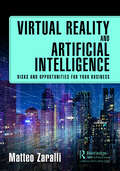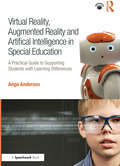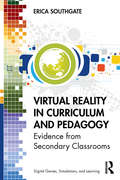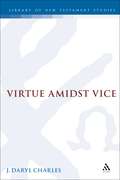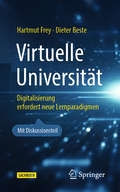- Table View
- List View
Virtual Literacies: Interactive Spaces For Children And Young People (Routledge Research In Education Ser. (PDF) #84)
by Guy Merchant Julia Gillen Jackie Marsh Julia DaviesThe growth of interest in virtual worlds and other online spaces for children and young people raises important issues for literacy educators and researchers. This book is a timely and much-needed collection of current research in the area. It provides a synthesis of knowledge and understanding and will be a key resource for scholars, students and teachers, particularly those interested in digital literacies. The work presents a coherent vision of current knowledge, and some of the most engaging, empirical research being undertaken on virtual worlds and online spaces in and beyond educational institutions. It contains international studies from the UK, North America and Australasia. This is an important time for those researching virtual worlds, videogaming and Web 2.0 technologies, since there is growing professional interest in their significance in the education and development of children and young people. Whether these technologies are solely associated with informal learning or whether they should be incorporated into classroom contexts is hotly debated. This book provides a principled evaluation and appreciation of the learning, teaching and instruction that can occur in digital environments, showing children, young people and those who work with them as active agents with possibilities to navigate new paths.
Virtual Reality and Artificial Intelligence: Risks and Opportunities for Your Business
by Matteo ZaralliTechnology is rapidly transforming the way people learn and train, and the integration of virtual reality (VR) and artificial intelligence (AI) could be the next big breakthrough. With the advent of Web 3.0 and the Metaverse, there are endless possibilities for creating immersive and engaging learning environments. However, there is also a need to address the risks and challenges that these technologies present.This book explores the risks and opportunities of VR and AI for coaching and training, with an eye toward the emerging trends of Web 3.0 and the Metaverse. Coaching and training have become increasingly important for companies seeking to develop and retain talent. With the advent of VR and AI technology, there is an opportunity to create immersive and engaging learning environments that could greatly enhance the learning experience. However, there are also risks associated with the use of these technologies, such as data privacy and cybersecurity.This book provides an in-depth analysis of the risks and opportunities of VR and AI for coaching and training, to help startup and business executives understand how to use these technologies responsibly and effectively. We need a new perspective. The book discusses the intersection of various major subjects and topics: business, innovation, technology, and philosophy in terms of critical thinking. The transition we are experiencing through this new Intelligent Revolution is very important, and soon everyone will witness the shift from e-learning to v-learning.
Virtual Reality and Artificial Intelligence: Risks and Opportunities for Your Business
by Matteo ZaralliTechnology is rapidly transforming the way people learn and train, and the integration of virtual reality (VR) and artificial intelligence (AI) could be the next big breakthrough. With the advent of Web 3.0 and the Metaverse, there are endless possibilities for creating immersive and engaging learning environments. However, there is also a need to address the risks and challenges that these technologies present.This book explores the risks and opportunities of VR and AI for coaching and training, with an eye toward the emerging trends of Web 3.0 and the Metaverse. Coaching and training have become increasingly important for companies seeking to develop and retain talent. With the advent of VR and AI technology, there is an opportunity to create immersive and engaging learning environments that could greatly enhance the learning experience. However, there are also risks associated with the use of these technologies, such as data privacy and cybersecurity.This book provides an in-depth analysis of the risks and opportunities of VR and AI for coaching and training, to help startup and business executives understand how to use these technologies responsibly and effectively. We need a new perspective. The book discusses the intersection of various major subjects and topics: business, innovation, technology, and philosophy in terms of critical thinking. The transition we are experiencing through this new Intelligent Revolution is very important, and soon everyone will witness the shift from e-learning to v-learning.
Virtual Reality, Augmented Reality and Artificial Intelligence in Special Education: A Practical Guide to Supporting Students with Learning Differences
by Ange AndersonNew technologies and ongoing developments in the fields of Virtual reality, augmented reality and artificial intelligence are changing the ways in which we facilitate learning. Recognising the positive role these technologies can play in the learning and progress of students assessed as having special educational needs, this practical guide explains the characteristics, benefits, risks and potential applications of new technologies in the classroom. An innovative and timely resource, Virtual Reality, Augmented Reality and Artificial Intelligence in Special Education offers a background in the evidence-based theory and practice of using new technologies in an educational context. Accessible and free of complex jargon, chapters provide information on the development, intended uses and most current terminology used in relation to technologies, and explains how modern equipment, approaches and possibilities can be used to promote improved communication skills, independent learning and heightened self-esteem amongst students diagnosed with SEND. Offering a wealth of practical tips, downloadable resources and ideas for engaging with technology in the classroom, the text will support teachers to ensure that students can benefit from exciting technological advances and learn to use them appropriately. Demystifying a complex and varied field, this practical resource will inspire and inform teachers, SENCOs and practitioners working with children and students with SEND as they harness the use of technology in the classroom.
Virtual Reality, Augmented Reality and Artificial Intelligence in Special Education: A Practical Guide to Supporting Students with Learning Differences
by Ange AndersonNew technologies and ongoing developments in the fields of Virtual reality, augmented reality and artificial intelligence are changing the ways in which we facilitate learning. Recognising the positive role these technologies can play in the learning and progress of students assessed as having special educational needs, this practical guide explains the characteristics, benefits, risks and potential applications of new technologies in the classroom. An innovative and timely resource, Virtual Reality, Augmented Reality and Artificial Intelligence in Special Education offers a background in the evidence-based theory and practice of using new technologies in an educational context. Accessible and free of complex jargon, chapters provide information on the development, intended uses and most current terminology used in relation to technologies, and explains how modern equipment, approaches and possibilities can be used to promote improved communication skills, independent learning and heightened self-esteem amongst students diagnosed with SEND. Offering a wealth of practical tips, downloadable resources and ideas for engaging with technology in the classroom, the text will support teachers to ensure that students can benefit from exciting technological advances and learn to use them appropriately. Demystifying a complex and varied field, this practical resource will inspire and inform teachers, SENCOs and practitioners working with children and students with SEND as they harness the use of technology in the classroom.
Virtual Reality in Curriculum and Pedagogy: Evidence from Secondary Classrooms (Digital Games, Simulations, and Learning)
by Erica SouthgateVirtual Reality in Curriculum and Pedagogy explores the instructional, ethical, practical, and technical issues related to the integration of immersive virtual reality (VR) in school classrooms. The book’s original pedagogical framework is informed by qualitative and quantitative data collected from the first-ever study to embed immersive VR in secondary school science, ICT, and drama classrooms. Students and scholars of technology-enhancing learning, curriculum design, and teacher education alike will find key pedagogical insights into leveraging the unique properties of VR for authentic, metacognitive, and creative learning.
Virtual Reality in Curriculum and Pedagogy: Evidence from Secondary Classrooms (Digital Games, Simulations, and Learning)
by Erica SouthgateVirtual Reality in Curriculum and Pedagogy explores the instructional, ethical, practical, and technical issues related to the integration of immersive virtual reality (VR) in school classrooms. The book’s original pedagogical framework is informed by qualitative and quantitative data collected from the first-ever study to embed immersive VR in secondary school science, ICT, and drama classrooms. Students and scholars of technology-enhancing learning, curriculum design, and teacher education alike will find key pedagogical insights into leveraging the unique properties of VR for authentic, metacognitive, and creative learning.
Virtual Reality in Softskill-Training und Coaching: Theoretische und praktische Einführung sowie Anwendungsbeispiele
by Ellena WerningVirtual Reality ist längst kein Hype mehr. Die Anwendung dieser innovativen Technologie ist längst im Alltag vieler Unternehmen angekommen. Noch nicht vollständig wird das Potenzial im Softskill-Training und Coaching genutzt. Gerade aber die jüngsten Entwicklungen im Bereich der künstlichen Intelligenz erweitern noch einmal die Nutzungsmöglichkeiten und die Wirksamkeit von Virtual Reality Lern- und Coachingumgebungen. Verschiedene Studien zeigen, wie durch Virtual Reality sowohl die Trainingsdauer reduziert als auch die Nachhaltigkeit des Lernens verbessert werden kann. Im Coaching bietet die Technologie eine völlig neue Art des Erfahrens von Ängsten, innerer Blockaden sowie des Assoziierens und Dissoziierens von Problemen. Zudem können neue Lösungswege visualisiert und innerlich erprobt werden.Dieses Buch bietet einen Überblick über die wesentlichen Vorzüge, Anwendungsmöglichkeiten und Grenzen des Einsatzes von Virtual Reality im Softskill-Training und Coaching. Es wird analysiert, welche Erkenntnisse aus verschiedenen Lern- und Medientheorien für die Gestaltung von VR-Lern- und Coachingwelten gewonnen werden können und welche Faktoren beachtet werden sollten, um die Potenziale von Lern- und Erkenntnisprozessen durch die Nutzung von Virtual Reality nutzen zu können. Ferner werden einfach umzusetzende Anwendungsmöglichkeiten aufgezeigt. Das Buch liefert somit ein theoretisches Fundament und zeigt gleichzeitig praktische Anwendungsbeispiele auf.
Virtual Sites as Learning Spaces: Critical Issues on Languaging Research in Changing Eduscapes
by Sangeeta Bagga-Gupta Giulia Messina Dahlberg Ylva LindbergThis volume fills a gap in the literature between the domains of Communication Studies and Educational Sciences across physical-virtual spaces as they intersect in the 21st century. The chapters focus on “languaging” - communicative practices in the making - and its intersection with analogue and virtual learning spaces, bringing together studies that highlight the constant movement between analogue-virtual dimensions that continuously re-shape participants' identity positionings. Languaging is understood as the deployment of one or more than one language variety, modality, embodiment, etc in human meaning-making across spaces. Languaging activities are explored through a multitude of literary artefacts, genres, media, and modes produced in and across sites. The authors go beyond “best practice” approaches and instead present “how-to-explore” communicative practices for researchers, learners and teachers. This book will be of interest to readers situated in the areas of literacy, literature, bi/multilingualism, multimodality, linguistic anthropology, applied linguistics, and related fields. Chapters 2, 5, 8 and 12 are open access under a CC BY 4.0 license at link.springer.com.
»Virtual Skills Lab« - Transdisziplinäres Forschen zur Vermittlung sozialer Kompetenzen im digitalen Wandel (Digitale Gesellschaft #58)
by Klaus Neundlinger Elisabeth Frankus Ines Häufler Thomas Layer-Wagner Simone Kriglstein Beate SchrankInter- bzw. transdisziplinäre Forschungsarbeit ist im aktuellen Wissenschaftsbereich häufig gängige Praxis, obwohl die Verständnisse über Umfang und Strukturen einer solchen Zusammenarbeit keineswegs einheitlich sind. Die Autor*innen vermitteln anhand eines Virtual-Reality-Trainings für soziale Kompetenzen Einblicke in die Prozesse des gemeinsamen Forschens. In einer Reihe von Gesprächen reflektieren sie über die Ideenfindung zu ihrem Projekt des »Virtual Skills Lab«, die Entwicklung der dazugehörigen Forschungsfrage sowie deren Ausarbeitung in Form der interaktiven Szene. Entlang dieses Beispiels für virtuelles Training werden schließlich praktische Empfehlungen zur Gestaltung der übergreifenden Zusammenarbeit im digitalen Wandel angeboten.
The Virtual Student: A Profile and Guide to Working with Online Learners
by Rena M. Palloff Keith PrattThe Virtual Student is an essential resource for online educators working with students in higher education and training settings. The authors offer an overview of the key issues of student online learning and provide a practical guide to working with online students. The book covers a broad range of topics including learning styles, multicultural issues, evaluation, retention, and the challenging problems of plagiarism and cheating.
Virtual Training: The Art of Conducting Powerful Virtual Training that Engages Learners and Makes Knowledge Stick (Jeb Blount)
by Jeb BlountRemote learning has been around since the 18th century. Caleb Phillips began advertising correspondence courses in the Boston Gazette in 1728 allowing people, for the first time, to learn new skills no matter where they lived. For the past 300 years, virtual training, in its various formats, has been meandering into shore on an inevitable yet slow building tide. And then, just like that, everything changed. A global pandemic. Social distancing. Working from home. In an instant, the tide became a tsunami. The global pandemic accelerated the broad adoption of virtual instructor led training along with awareness that classroom-based training is often expensive, inefficient, and fails to deliver a fair return on investment. While it is certainly more challenging to re-create the collaborative environment of the physical classroom in a virtual setting, virtual training combines the structure, accountability, and social learning benefits of classroom training with speed, agility, and significant cost savings. Simply put, virtual training enables organizations to rapidly upskill more people, while generating a far higher return on the training investment. Virtual training is also green. Studies indicate that virtual training consumes nearly 90% less energy and produces 85% fewer CO2 emissions than classroom training. Still, the biggest challenge with virtual training, and the reason there has been so much resistance to it, is historically the experience has been excruciating. Not the quality of the curriculum or content. Not the talent of the trainer. The learning experience. There are few people who haven’t had the pleasure of sitting through agonizing virtual training sessions. Death by voice over PowerPoint, delivered by a disengaged instructor, has an especially bitter flavor. It is the way virtual training is delivered that matters most. When the virtual learning experience is emotionally positive: Participants are more engaged, embrace new competencies, and knowledge sticks Participants are more likely to show up to class and be open to future virtual training Trainers enjoy their work and gain fulfillment from making an impact Leaders book more virtual training Organizations more readily blend and integrate virtual training into learning & development initiatives This is exactly what this book is about. Virtual Training is the definitive guide to delivering virtual training that engages learners and makes new skills and behavioral changes stick. Jeb Blount, one of the most celebrated trainers and authors of our generation, walks you step-by-step through the seven elements of effective, engaging virtual learning experiences. Trainer Mindset & Emotional Discipline Production & Technology Media & Visuals Virtual Curriculum & Instructional Design Planning & Preparation Virtual Communication Skills Dynamic & Interactive Training Delivery As you dive into these powerful insights, and with each new chapter, you’ll gain greater and greater confidence in your ability to effectively deliver training in a virtual classroom. Once you master virtual training delivery and experience the power of remote learning, you may never want to go back to the physical classroom again.
Virtual Training: The Art of Conducting Powerful Virtual Training that Engages Learners and Makes Knowledge Stick (Jeb Blount)
by Jeb BlountRemote learning has been around since the 18th century. Caleb Phillips began advertising correspondence courses in the Boston Gazette in 1728 allowing people, for the first time, to learn new skills no matter where they lived. For the past 300 years, virtual training, in its various formats, has been meandering into shore on an inevitable yet slow building tide. And then, just like that, everything changed. A global pandemic. Social distancing. Working from home. In an instant, the tide became a tsunami. The global pandemic accelerated the broad adoption of virtual instructor led training along with awareness that classroom-based training is often expensive, inefficient, and fails to deliver a fair return on investment. While it is certainly more challenging to re-create the collaborative environment of the physical classroom in a virtual setting, virtual training combines the structure, accountability, and social learning benefits of classroom training with speed, agility, and significant cost savings. Simply put, virtual training enables organizations to rapidly upskill more people, while generating a far higher return on the training investment. Virtual training is also green. Studies indicate that virtual training consumes nearly 90% less energy and produces 85% fewer CO2 emissions than classroom training. Still, the biggest challenge with virtual training, and the reason there has been so much resistance to it, is historically the experience has been excruciating. Not the quality of the curriculum or content. Not the talent of the trainer. The learning experience. There are few people who haven’t had the pleasure of sitting through agonizing virtual training sessions. Death by voice over PowerPoint, delivered by a disengaged instructor, has an especially bitter flavor. It is the way virtual training is delivered that matters most. When the virtual learning experience is emotionally positive: Participants are more engaged, embrace new competencies, and knowledge sticks Participants are more likely to show up to class and be open to future virtual training Trainers enjoy their work and gain fulfillment from making an impact Leaders book more virtual training Organizations more readily blend and integrate virtual training into learning & development initiatives This is exactly what this book is about. Virtual Training is the definitive guide to delivering virtual training that engages learners and makes new skills and behavioral changes stick. Jeb Blount, one of the most celebrated trainers and authors of our generation, walks you step-by-step through the seven elements of effective, engaging virtual learning experiences. Trainer Mindset & Emotional Discipline Production & Technology Media & Visuals Virtual Curriculum & Instructional Design Planning & Preparation Virtual Communication Skills Dynamic & Interactive Training Delivery As you dive into these powerful insights, and with each new chapter, you’ll gain greater and greater confidence in your ability to effectively deliver training in a virtual classroom. Once you master virtual training delivery and experience the power of remote learning, you may never want to go back to the physical classroom again.
The Virtual University: The Internet and Resource-based Learning (Open and Flexible Learning Series)
by Steve Ryan Bernard Scott Howard Freeman Daxa PatelA discussion of the increased accessibility to the Internet and how this has lead to a variety of resources being used for learning. Case studies and examples show the benefits of using the Internet as part of resource-based learning.
The Virtual University: The Internet and Resource-based Learning (Open and Flexible Learning Series)
by Steve Ryan Bernard Scott Howard Freeman Daxa PatelA discussion of the increased accessibility to the Internet and how this has lead to a variety of resources being used for learning. Case studies and examples show the benefits of using the Internet as part of resource-based learning.
Virtualization of Universities: Digital Media and the Organization of Higher Education Institutions (Innovation, Technology, and Knowledge Management #0)
by Thomas PfefferThe purpose of this volume is to shape conceptual tools to understand the impact of new information and communication technologies (ICTs) on the organization of universities. Traditional research-based universities, the most typical representatives of the higher education system, find themselves challenged by the speed and the wide range of technical innovations, but also by a vast array of implicit assumptions and explicit promises associated with the distribution of digital media.The author observes that as universities increasingly use digital media (computers and the Internet) to accomplish their tasks, a transformation takes place in an evolutionary rather than in a revolutionary way. Using the University of Klagenfurt as an in-depth case study, he explores such dynamic issues as how digital media affect the practice of research, the preservation and dissemination of knowledge (for example, through publishing and archiving), and delivery of education at universities. More broadly, he considers issues of organizational culture and design, administration, and leadership as universities integrate digital technologies into all aspects of their operations.
Virtue amidst Vice: The Catalog of Virtues in 2 Peter 1 (The Library of New Testament Studies #150)
by J. Daryl CharlesVirtue amidst Vice represents an attempt to probe a relatively obscure portion of a relatively obscure New Testament document. 2 Peter reflects a social setting that presents a most daunting pastoral challenge. The danger confronting the Christian community is a lapse in ethical standards and a return-whether by mere forgetfulness or in wholesale apostasy-to the former way of life. 2 Peter's prophetic and paraenetic response borrows from the moral grammar of contemporary moral philosophers in exhorting the readers to recall-and validate through virtuous living-the faith they have received. The theme of the moral life runs throughout 2 Peter, with the various components of the author's literary arsenal subordinated to this thematic development. It is the function of the catalogue of virtues (1.5-7) both to introduce and to anchor the author's call to repel moral scepticism and reinvigorate the moral life.
Virtue and the Quiet Art of Scholarship: Reclaiming the University (Routledge Research in Higher Education)
by Anne PirrieVirtue and the Quiet Art of Scholarship offers a fresh perspective on what it is to be a ‘good knower’ in a social and educational environment dominated by the market order. It explores how narrowly conceived epistemic virtues might be broadened out by seeing those who work and study in the university in their full humanity. In an era characterized by deep and enduring social and cultural divisions, it offers a timely, accessible and critical perspective on the perils of retreating behind disciplinary boundaries, reminding readers of the need to remain open to the other in a time of increased social and political polarization. Drawing on the work of Leonard Cohen, Ali Smith, Italo Calvino and Raymond Carver, the book seeks to move across disciplines and distort the line between the humanities and the social sciences as a way of bringing them closer together. It explores virtue in the context of scholarship and research, particularly how the ‘virtues of unknowing’ challenge traditional notions of the ‘good knower’. The book offers the framework within which to bridge the gap between ‘us’ and ‘them’ in relation to developments in the university sector, addressing the urgent need for a form of language that promotes unity over division. Virtue and the Quiet Art of Scholarship will be vital reading for academics, researchers and postgraduate students in the fields of philosophy of education, sociology of education, research methods in education and education policy.
Virtue and the Quiet Art of Scholarship: Reclaiming the University (Routledge Research in Higher Education)
by Anne PirrieVirtue and the Quiet Art of Scholarship offers a fresh perspective on what it is to be a ‘good knower’ in a social and educational environment dominated by the market order. It explores how narrowly conceived epistemic virtues might be broadened out by seeing those who work and study in the university in their full humanity. In an era characterized by deep and enduring social and cultural divisions, it offers a timely, accessible and critical perspective on the perils of retreating behind disciplinary boundaries, reminding readers of the need to remain open to the other in a time of increased social and political polarization. Drawing on the work of Leonard Cohen, Ali Smith, Italo Calvino and Raymond Carver, the book seeks to move across disciplines and distort the line between the humanities and the social sciences as a way of bringing them closer together. It explores virtue in the context of scholarship and research, particularly how the ‘virtues of unknowing’ challenge traditional notions of the ‘good knower’. The book offers the framework within which to bridge the gap between ‘us’ and ‘them’ in relation to developments in the university sector, addressing the urgent need for a form of language that promotes unity over division. Virtue and the Quiet Art of Scholarship will be vital reading for academics, researchers and postgraduate students in the fields of philosophy of education, sociology of education, research methods in education and education policy.
Virtue, Emotion and Imagination in Law and Legal Reasoning
by Amalia Amaya Maksymilian Del MarWhat is the role and value of virtue, emotion and imagination in law and legal reasoning? These new essays, by leading scholars of both law and philosophy, offer striking and exploratory answers to this neglected question. The collection takes a holistic approach, inquiring as to the connections and relations between virtue, emotion and imagination. In addition to the principal focus on adjudication, essays in the collection also engage with a variety of different legal, political and moral contexts: eg criminal law sentencing, the Black Lives Matter movement and professional ethics. A number of different areas of the law are addressed (eg criminal law, constitutional law and tort law) and the issues explored include: the benefits and limits of empathy in legal reasoning; the role of attention and perception in judicial reasoning;, the identification of judicial virtues (such as compassion and humility) and judicial vices (such as callousness and partiality); the values and dangers of certain imaginative devices (eg personification); and the interactive and social dimensions of virtue, emotion and imagination.
Virtue, Emotion and Imagination in Law and Legal Reasoning
What is the role and value of virtue, emotion and imagination in law and legal reasoning? These new essays, by leading scholars of both law and philosophy, offer striking and exploratory answers to this neglected question. The collection takes a holistic approach, inquiring as to the connections and relations between virtue, emotion and imagination. In addition to the principal focus on adjudication, essays in the collection also engage with a variety of different legal, political and moral contexts: eg criminal law sentencing, the Black Lives Matter movement and professional ethics. A number of different areas of the law are addressed (eg criminal law, constitutional law and tort law) and the issues explored include: the benefits and limits of empathy in legal reasoning; the role of attention and perception in judicial reasoning;, the identification of judicial virtues (such as compassion and humility) and judicial vices (such as callousness and partiality); the values and dangers of certain imaginative devices (eg personification); and the interactive and social dimensions of virtue, emotion and imagination.
Virtuelle Aufgabenbearbeitung in mehrsprachigen Gruppen: Eine qualitative Studie in der Französischlehrerbildung (Literatur-, Kultur- und Sprachvermittlung: LiKuS)
by Ramona SchneiderVirtuelle Kooperationsprojekte werden immer häufiger zur Professionalisierung von zukünftigen Fremdsprachenlehrenden eingesetzt. Ramona Schneider untersucht diese komplexen Settings erstmalig in ihrer Vielschichtigkeit unter Zusammenführung einer inhaltlich-fachlichen, sprachlichen, virtuellen, sozialen, institutionellen, individuellen und autonomen Ebene. Hierzu entwickelt die Autorin ein mehrdimensionales Erhebungs- und Analyseverfahren. Anhand von Befragungs- und Interaktionsdaten zeigt sie die wechselseitige Einflussnahme zwischen den Studierenden, den Gruppen und der Lernumgebung auf und entwickelt ein Modell virtueller kooperativer Nicht-Partizipation.
Virtuelle Universität: Digitalisierung erfordert neue Lernparadigmen (Technik im Fokus)
by Hartmut Frey Dieter BesteDas Buch vermittelt das Konzept einer globalen, virtuellen Universität in Kombination mit neuen Erkenntnissen aus der Lernforschung. Hierbei werden mithilfe von künstlicher Intelligenz bewegungsorientierte, virtuelle 3-D-Bilder eingebunden. Dadurch wird die Lernbereitschaft und damit auch die Kreativität des Einzelnen angeregt. So werden bereits heute Schweißer in Großunternehmen mittels Datenbrille und intelligenter Avatare ausgebildet. Über eine virtuelle Universität lassen sich Forschungsprojekte initiieren und koordinieren. Problemlösungen lassen sich mit der Verwendung von Avataren in virtuellen Hörsälen erarbeiten. Die Zertifizierung erfolgt nicht mehr über das Abfragen von Wissensinhalten, sondern über die Fähigkeit Probleme zu lösen. Weitere wichtige Aspekte einer virtuellen Universität sind, im Vergleich zu den klassischen Universitäten, die geringen Kosten, die Möglichkeit bei der Entwicklung des Contents die besten Wissenschaftler zu beteiligen sowie die immer mehr um sich greifende Sekundär- und Tertiärforschung. Eine virtuelle Universität bietet die Chance der Emanzipation gesellschaftlicher Praxis von Wissenschaft durch Wissenschaft und Immunisierung gesellschaftlich geltende Ideologien und Interessenstandpunkte gegen wissenschaftliche Aufklärungsansprüche.
Virtuelle Veranstaltungen in Wissenschaft und Lehre: Eine praxisorientierte Einführung (essentials)
by Barbara Hey Friederike Bodenstein-DreslerDie Übertragung von Präsenzveranstaltungen in den virtuellen Raum ist für die meisten Forschenden und Lehrenden eine neue Herausforderung. Dieses essential stellt die damit verbundenen veränderten Regeln der Kommunikation mit den didaktischen und kommunikationspsychologischen Besonderheiten von Online-Formaten vor. Es zeigt, worauf es bei der E-Moderation virtueller akademischer Veranstaltungen ankommt und welche Instrumente helfen, Aufmerksamkeit, Motivation und Interaktion zu stärken. Best-Practice-Beispiele sowie Erfahrungen aus Wissenschaft und Lehre komplettieren dieses essential und machen es zu einer wertvollen Informationsquelle für Forschende und Lehrende zur Gestaltung virtueller Formate im wissenschaftlichen Kontext.
Virtues in the Public Sphere: Citizenship, Civic Friendship and Duty
by James ArthurVirtues in the Public Sphere features seventeen chapters by experts from a variety of different perspectives on the broad theme of virtue in the public sphere. Spanning issues such as the notion of civic friendship and civic virtue, it sheds light on the role that these virtues play in the public sphere and their importance in safeguarding communities from the threats of a lack of concern for truth, poor leadership, charlatanism, and bigotry. This book highlights the theoretical complexity of putting virtue ethics into practice in the public domain at a time when it has been shaken by unpredictable political, social, technological, and cultural developments. With contributions from internationally acclaimed scholars in the fields of philosophy, psychology, sociology, and education, this book highlights the main issues, both theoretical and practical, of putting virtue ethics into practice in the public domain. Split into three sections – "Virtues and vices in the public sphere", "Civic friendship and virtue", and "Perspectives on virtue and the public sphere" – the chapters offer a timely commentary on the roles that virtues have to play in the public sphere. This timely book will be of great interest to researchers, academics, and post-graduate students in the fields of education, character and virtue studies, and will also appeal to practitioners.

